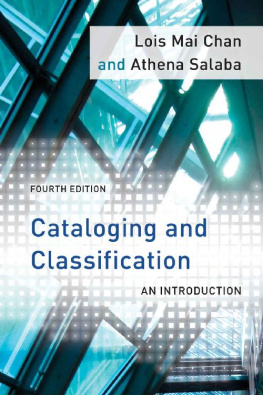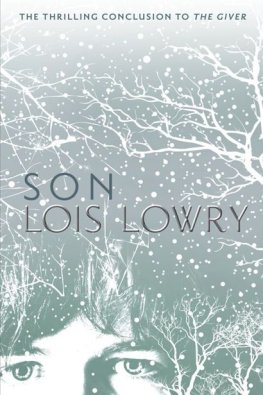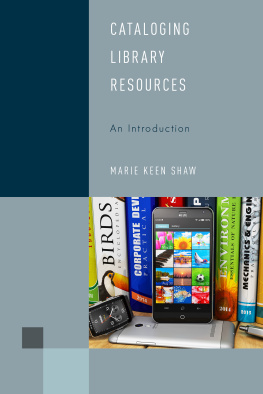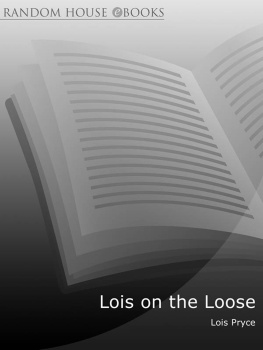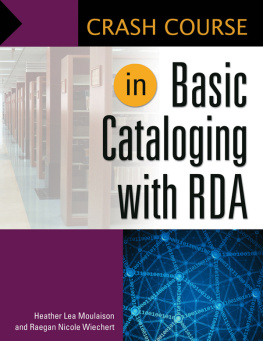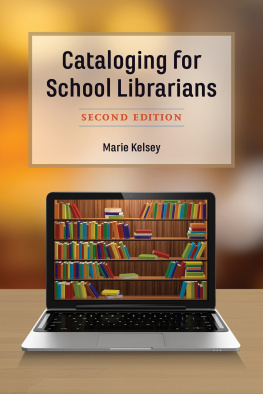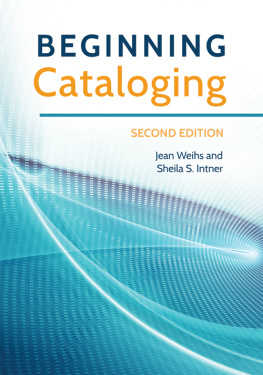Chan Lois Mai - Cataloging and classification: an introduction
Here you can read online Chan Lois Mai - Cataloging and classification: an introduction full text of the book (entire story) in english for free. Download pdf and epub, get meaning, cover and reviews about this ebook. City: Lanham, Md, year: 2016, publisher: Rowman & Littlefield Publishers, Inc., genre: Home and family. Description of the work, (preface) as well as reviews are available. Best literature library LitArk.com created for fans of good reading and offers a wide selection of genres:
Romance novel
Science fiction
Adventure
Detective
Science
History
Home and family
Prose
Art
Politics
Computer
Non-fiction
Religion
Business
Children
Humor
Choose a favorite category and find really read worthwhile books. Enjoy immersion in the world of imagination, feel the emotions of the characters or learn something new for yourself, make an fascinating discovery.
- Book:Cataloging and classification: an introduction
- Author:
- Publisher:Rowman & Littlefield Publishers, Inc.
- Genre:
- Year:2016
- City:Lanham, Md
- Rating:5 / 5
- Favourites:Add to favourites
- Your mark:
- 100
- 1
- 2
- 3
- 4
- 5
Cataloging and classification: an introduction: summary, description and annotation
We offer to read an annotation, description, summary or preface (depends on what the author of the book "Cataloging and classification: an introduction" wrote himself). If you haven't found the necessary information about the book — write in the comments, we will try to find it.
Cataloging and classification: an introduction — read online for free the complete book (whole text) full work
Below is the text of the book, divided by pages. System saving the place of the last page read, allows you to conveniently read the book "Cataloging and classification: an introduction" online for free, without having to search again every time where you left off. Put a bookmark, and you can go to the page where you finished reading at any time.
Font size:
Interval:
Bookmark:
Cataloging and Classification
Cataloging and Classification
An Introduction
Fourth Edition
Lois Mai Chan and Athena Salaba
ROWMAN & LITTLEFIELD PUBLISHERS, INC.
Lanham Boulder New York Toronto Plymouth, UK
Published by Rowman & Littlefield
A wholly owned subsidiary of The Rowman & Littlefield Publishing Group, Inc.
4501 Forbes Boulevard, Suite 200, Lanham, Maryland 20706
www.rowman.com
Unit A, Whitacre Mews, 26-34 Stannary Street, London SE11 4AB
Copyright 2016 by Rowman & Littlefield
All rights reserved. No part of this book may be reproduced in any form or by any electronic or mechanical means, including information storage and retrieval systems, without written permission from the publisher, except by a reviewer who may quote passages in a review.
British Library Cataloguing in Publication Information Available
Library of Congress Cataloging-in-Publication Data
Names: Chan, Lois Mai, author. | Salaba, Athena, author.
Title: Cataloging and classification : an introduction / Lois Mai Chan and Athena Salaba.
Description: Fourth edition. | Lanham : Rowman & Littlefield, [2016] | Includes bibliographical references and index.
Identifiers: LCCN 2015028244 | ISBN 9781442232488 (cloth : alk. paper) | ISBN 9781442232495 (pbk. : alk. paper) | ISBN 9781442232501 (electronic)
Subjects: LCSH: Cataloging. | ClassificationBooks. | Resource description & access.
Classification: LCC Z693 .C437 2016 | DDC 025.3dc23 LC record available at http://lccn.loc.gov/2015028244
 The paper used in this publication meets the minimum requirements of American National Standard for Information SciencesPermanence of Paper for Printed Library Materials, ANSI/NISO Z39.48-1992.
The paper used in this publication meets the minimum requirements of American National Standard for Information SciencesPermanence of Paper for Printed Library Materials, ANSI/NISO Z39.48-1992.
Printed in the United States of America
LOIS MAI CHAN, 19342014
This fourth edition of the classic Introduction to Cataloging and Classification represents Dr. Chans final scholarly contribution after a long and distinguished career. She was a prolific author whose other major books include, Library of Congress Subject Headings, Principles and Application , Dewey Decimal Classification: Principles and Application , A Guide to the Library of Congress Classification , and Fast: Faceted Application of Subject Terminology . For over thirty years her works have made cataloging understandable to thousands of students and practicing librarians. Her scholarly contributions also include her extensive research and writing about cataloging issues and include more than sixty scholarly articles and numerous talks and lectures. Her prolific writing on subject analysis and other library issues shaped the modern view of information organization.
A native of China, she received an AB in foreign languages from National Taiwan University followed MA in English and a MS in library science from Florida State University. She was a cataloger at several academic libraries before earning her PhD in comparative literature from University of Kentucky. Dr. Chan joined the faculty at the University of Kentuckys School of Library and Information Science in 1970, where she shared her enthusiasm for cataloging and educated several generations of librarians on the art and science information organization. She contributed to the enhancement or creation of the major schemas for subject analysis as a consultant to the Library of Congress on the Library of Congress Subject Headings and the Library of Congress Classification and to OCLC on the Dewey Decimal Classification and the Facetted Application of Subject Terminology (FAST).
Dr. Chan was very involved in professional associations. She was member of the American Library Association since 1960 where she served on numerous committees including the Subject Analysis Committee, the International Relations Committee, and the Executive Committee of the Cataloging and Classification Section. She was active in the International Federation of Library Associations and Institutions where she was a member of the Classification and Indexing and Knowledge Management Standing Committees and the Working Group on the Functional Requirements for Subject Authority Records. In 1989, she was the recipient of the Margaret Mann Citation, the highest honor in cataloging bestowed by the American Library Association, and in 2006 the recipient of the Beta Phi Mu Award, presented to a library school faculty member or to an individual for distinguished service to education in librarianship.
Dr. Chan was a dedicated mother and grandmother, a loving wife, and an esteemed colleague. She is survived by her husband, S. K.; daughter, Jennifer; son, Stephen; daughter-in-law, Sol; and grandsons, Zachary and Isaac. She is greatly missed by her family and those who had an opportunity to work with her, particularly by those of us who also knew her as a valued friend.

Photo contributed by Dr. Ed ONeill, retired from OCLC.
Contents
Since the publication of the third edition of Cataloging and Classification: An Introduction , the landscape, scope, and nature of bibliographic control in libraries have undergone enormous changes. In addition to their own print and non-print sources, libraries now rely heavily on external or remote sources available on the Internet and the Web, which have become important milieus for knowledge discovery. Libraries offer access to a range of digitized resources. Web resources, in particular, possess characteristics that are a far cry from those found among traditional library resources. The field of information organization has seen major developments this past decade. New ways of modeling todays bibliographic environment have been developed and, as a result, new standards for organizing resources have been created to accommodate the new information environment. Most notably, the functional requirements family models have been completed and released, resulting in the development of a new standard for describing information resources, the Resource Description and Access (RDA).
The adoption of the first three editions of this book by many library and information science programs as an introductory text for beginner in cataloging and classification, and by many cataloging departments as a training tool, has encouraged the preparation of the fourth edition. As in the case of the first three editions, the primary intended audience of the new edition consists of students in library and information science programs, beginning professionals working in the areas of resource description and organization, and public service librarians seeking a fuller understanding of the bibliographic control apparatus. It may also be useful to professionals in related fields who are concerned with knowledge organization, for example, indexers, abstractors, bibliographers, publishers, and information system designers. Individual chapters within the book may also be used separately in training or review classes dealing with information organization, storage, and retrieval. The scope of this new edition is the analysis and representation of methods used in describing, organizing, and providing access to resources made available in or through libraries, including both the materials owned by the library (mostly physical items such as books, journals, and nonprint materials) and external resources such as those in electronic form that are accessible through the librarys portal. In other words, the frame of reference for the book is todays library environment and its emphasis is on the standards for bibliographic control that have been widely adopted in the library field. It reports on recent developments in the retrieval arena, but technical details, particularly with regard to online systems, have been excluded because they vary from system to system and are subject to rapid changes.
Next pageFont size:
Interval:
Bookmark:
Similar books «Cataloging and classification: an introduction»
Look at similar books to Cataloging and classification: an introduction. We have selected literature similar in name and meaning in the hope of providing readers with more options to find new, interesting, not yet read works.
Discussion, reviews of the book Cataloging and classification: an introduction and just readers' own opinions. Leave your comments, write what you think about the work, its meaning or the main characters. Specify what exactly you liked and what you didn't like, and why you think so.

